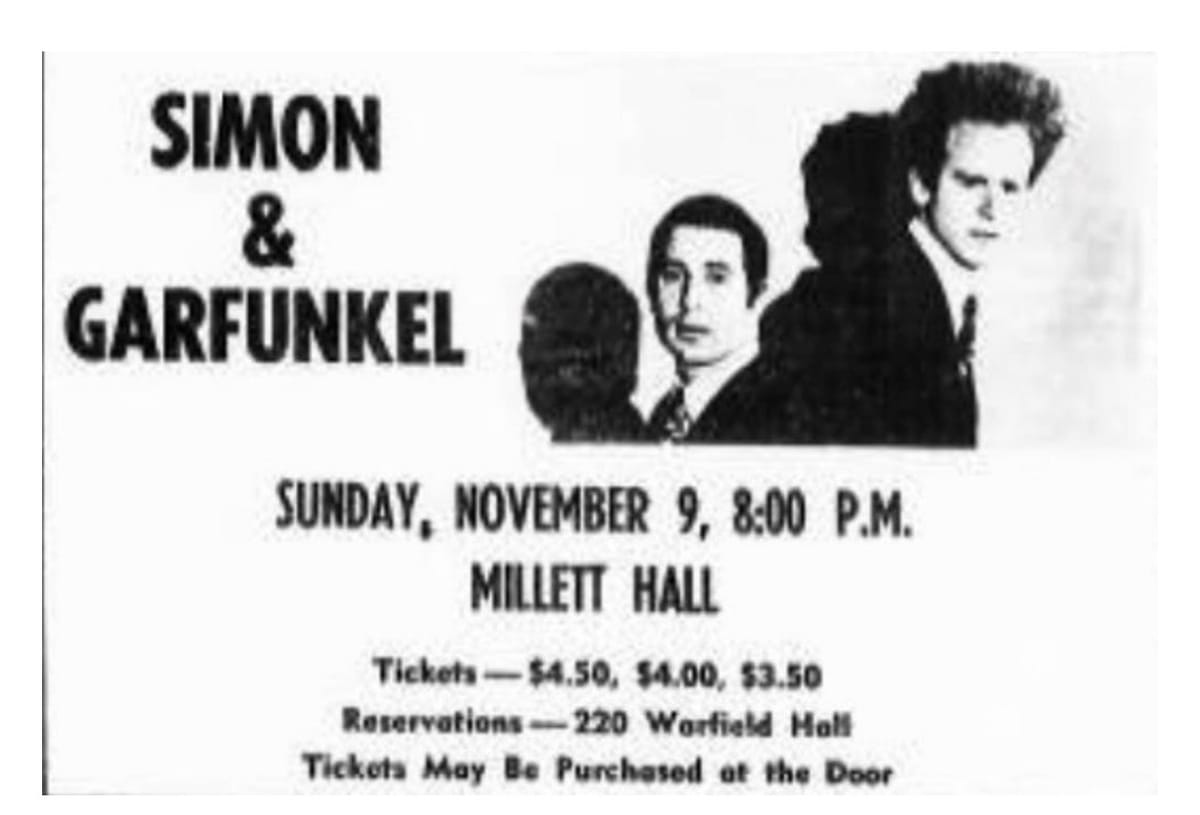Save Millett: Arena over troubled water
With Miami University considering demolishing Millett Hall to build a new arena, Oxford Free Press Board Secretary Richard Campbell looks back at one iconic performance in the arena.

Miami is apparently considering demolishing Millett Hall — not the most attractive building on campus, despite tons of red brickage.
Built to host basketball games and ROTC offices, Millett cost $7.5 million (that’s about $65 million today). It opened Dec. 2, 1968, with Miami losing to the Kentucky Wildcats, 86-77. That season, Miami would later lose to Purdue in the NCAA regional semifinals. Kentucky would lose to Marquette, my alma mater, in the same regional round. UCLA beat Purdue in the finals.
For me, though, Millett should be saved for historic reasons other than sports. According to local folklore, Paul Simon and Art Garfunkel first performed their iconic “Bridge Over Troubled Water” at Millett before an audience of more than 11,000 on Nov. 9, 1969. New York’s Carnegie Hall and Detroit’s Cobo Arena (the most likely location of the first performance) make similar claims about the song’s public debut 55 years ago this month. A music review of a Nov. 2, 1969 performance in the Detroit Free Press lists “Bridge” as one of the songs performed that evening, but let’s not tamper with the Miami legend.
You can still listen to the performance on YouTube. Just search Simon & Garfunkel, “Bridge Over Troubled Water,” Miami University, 1969. Make sure to listen to the applause after. Concert audiences often boo new material (they just want the familiar stuff), but Oxford knew the duo had a hit.
A 2011 documentary about the making of the “Bridge Over Troubled Water” album, titled “The Harmony Game,” features audience shots of the performance that night at Millett, although either the filmmaker or YouTube got the date wrong.
Oxford was the fifth or sixth stop on the concert tour that year (records are sketchy on this point), but the duo apparently saved the song’s college debut for Miami University. A semi-famous Yellow Dog bootleg album of the concert exists, once upon a time praised for its sound quality.
Valerie Elliott, a Talawanda and Miami grad, recalls a “ticket glitch” that night. She was there with high school friends, but the box office said the concert was sold out. Later, using ticket stubs obtained from friends “on the other side of the turnstile,” they found empty floor seats that the glitch had left vacant. “The big thing,” she recalls, “was hearing ‘Bridge Over Troubled Water’ for the first time. We knew all the other songs, but hearing a new one was unexpectedly cool.”
Christine Scholl, another Talawanda and Miami grad, was also there with friends. “I was in the front row,” she said. “During the break, Sue Klein and I talked to Simon’s brother [Eddie] who looked just like Simon. I went with my mother because she loved them as much as I did.”
I also experienced Simon & Garfunkel live as a high schooler. It was March 1967 at the University of Dayton Fieldhouse, my first concert. It was a senior field trip led by my Carroll High School English teacher extraordinaire, Sister Marie Christopher. She taught me how to write and, on the side, taught Bob Dylan and Simon & Garfunkel lyrics as poetry.
“Bridge Over Troubled Water” would be the duo’s last studio album, debuting in 1970 and selling more than 25 million copies. The song won a Grammy for best song in 1971. By then, Garfunkel had already left to make movies, co-starring in “Catch-22” and “Carnal Knowledge.” The duo’s work had served earlier as the soundtrack for "The Graduate.” Simon went on to a successful solo career.
Although Simon and Garfunkel broke up in 1970, they reunited briefly, including a historic appearance in 1981 for a benefit concert in New York’s Central Park. The crowd was estimated at 500,000, five times the capacity of the largest stadium in the U.S. That performance produced another album and film. As a duo, Simon and Garfunkel were inducted into the Rock and Roll Hall of Fame in 1990. Simon was inducted again in 2001 as a solo artist.
Like Simon and Garfunkel, Millett Hall, named after Miami’s 16th president, John Millett, has its own Wikipedia site. It lists other performers who have appeared there over the years, including Elton John, Dave Matthews, Tony Bennett, Sting, Bob Dylan,, Dave Chappelle, Bruce Springsteen, Fleetwood Mac, R.E.M., and 50 Cent, among others.
I’ve even had students look into the legendary performance. After I told my honors class at Miami about the performance in 2014, one industrious first-year student, Emily Williams, wrote about it for The Miami Student. She would later go on to be editor for that publication.
So I say, “Save Millett!” and all the mortar and memories. Do we really want to knock down a building that is the stuff of legend with its own Wikipedia page?
Richard Campbell is a professor emeritus and founding chair of the Department of Media, Journalism & Film at Miami. He is the board secretary for the Oxford Free Press.



